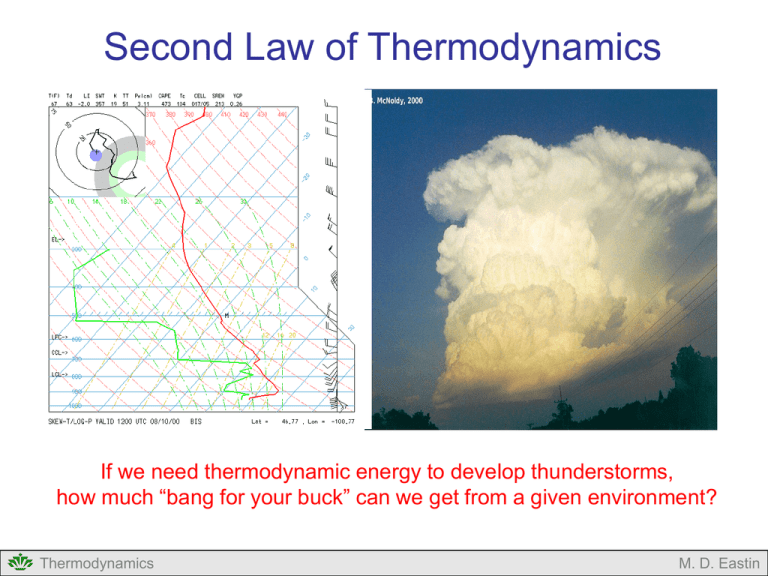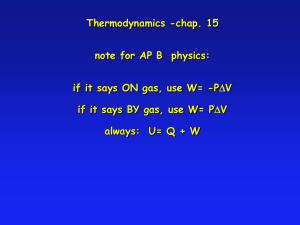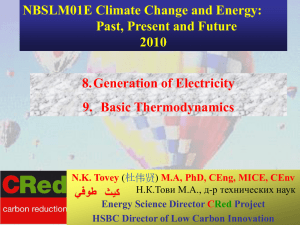Second Law of Thermodynamics
advertisement

Second Law of Thermodynamics If we need thermodynamic energy to develop thunderstorms, how much “bang for your buck” can we get from a given environment? Thermodynamics M. D. Eastin Second Law of Thermodynamics Outline: Review of The First Law of Thermodynamics The Second Law of Thermodynamics Types of Processes The Carnot Cycle Applications Concept of Entropy Reversible processes Irreversible processes Combining the First and Second Laws Applications Consequences of the Second Law Entropy and Potential Temperature Atmospheric Motions Thermodynamics M. D. Eastin First Law of Thermodynamics Statement of Energy Balance / Conservation: • Energy in = Energy out • Heat in = Heat out dq cvdT pdα Heating Sensible heating Latent heating Evaporational cooling Radiational heating Radiational cooling Change in Internal Energy Work Done Expansion Compression • Says nothing about the direction of energy transfer • Says nothing about the efficiency of energy transfer Thermodynamics M. D. Eastin Second Law of Thermodynamics The Second Law of Thermodynamics determines whether a given process can naturally occur → Preferred direction of energy transfer → Fraction of heat that can be converted into work Often called the “Supreme Law of Nature” Application of the second law reveals that there are three types of thermodynamics processes that can occur without external forcing: • Natural (or Irreversible) • Impossible • Reversible Thermodynamics M. D. Eastin Types of Processes Irreversible (or Natural) Processes: Physical processes that proceeds in one direction but not the other Tend toward an equilibrium at their final state Example: Free Expansion of Gas What will happen when we open the valve? Vacuum Thermodynamics Valve Closed Gas M. D. Eastin Types of Processes Irreversible (or Natural) Processes: Physical processes that proceeds in one direction but not the other Tend toward an equilibrium at their final state Example: Free Expansion of Gas Initially, the gas rapidly expands to fill the vacuum For a period of time, the air “sloshes” back and forth (or oscillates) between the two regions Gas Thermodynamics Valve Open Eventually, the oscillation ceases and each region contains equal amounts of the gas Gas An equilibrium has been reached The entropy increases M. D. Eastin Types of Processes Irreversible (or Natural) Processes: Physical processes that proceeds in one direction but not the other Tend toward an equilibrium at their final state Example: Free Thermal Conduction What will happen over time? Hot Thermodynamics dQ Cold M. D. Eastin Types of Processes Irreversible (or Natural) Processes: Physical processes that proceeds in one direction but not the other Tend toward an equilibrium at their final state Example: Free Thermal Conduction Heat is gradually transferred from the hot region to the cold region Warm Warm Eventually, the two regions will have the same temperature (heat transfer stops) An equilibrium has been reached The entropy increases Thermodynamics M. D. Eastin Types of Processes Equilibrium: Physical processes that are time independent Properties of the system do not change with time Warm Gas Thermodynamics Valve Open Warm Gas M. D. Eastin Types of Processes Impossible Processes: Physical processes that do not occur naturally Takes a system away from equilibrium Example: Free Compression of Gas Gas Valve Open Gas Vacuum Valve Closed Gas Without external forcing, the gas will never compress itself to create a vacuum Thermodynamics M. D. Eastin Types of Processes Impossible Processes: Physical processes that do not occur naturally Takes a system away from equilibrium Example: Free Thermal Conduction Warm Hot Cold Without external forcing, the heat will not separate itself into a hot region and a cold region Thermodynamics M. D. Eastin Types of Processes Impossible Processes: Physical processes that do not occur naturally Can only occur with an input of work from the environment Example: Forced Thermal Conduction dW Thermodynamics M. D. Eastin Types of Processes Reversible Processes: Reversal in direction returns the system and the environment to its original state • A conceptual process • Idealized version of how things should be No process is truly reversible Conditions that allow processes to be almost reversible • Process occurs at a very slow rate • Each intermediate state of the system is an equilibrium state • State variables are at equilibrium Thermodynamics M. D. Eastin Types of Processes Distinction between Reversible and Irreversible Processes: Reversible: One can reverse the process and both the system and the environment will return to its original states Irreversible: One can reverse the process and return the system to its original state, but the environment will have suffered a permanent change from its original state. Thermodynamics M. D. Eastin Carnot Cycle Nicolas Leonard Sadi Carnot: • French engineer and physicist • Worked on early engines • Tried to improve their efficiency Studied idealized heat engines, cyclic processes, and reversible processes • Wrote his now famous paper, “A Reflection on the Motive Power of Fire” in 1824 Introduced the “Carnot Cycle” for an idealized, cyclic and reversible process http://en.wikipedia.org/wiki/Nicolas_L%C3%A9onard_Sadi_Carnot Thermodynamics M. D. Eastin Carnot Cycle Basic Concepts: Cyclic process: • A series of transformations by which the state of a system undergoes changes but the system is eventually returned to its original state • Changes in volume during the process may result in external work • The net heat absorbed by the system during the cyclic process is equivalent to the total external work done Reversible process: • Each transformation in the cyclic process achieves an equilibrium state Thermodynamics Transformations along A-B-C-D-A represents a cyclic process The entire process is reversible since equilibirum is achieved for each state (A, B, C, and D) M. D. Eastin Carnot Cycle Carnot’s Idealized Heat Engine: The Components • A “working substance” (blue dots) is in a cylinder (Y) with insulated walls and a conducting base (B) fitted with an insulated, frictionless piston (P) to which a variable force can be applied • A non-conducting stand (S) upon which the cylinder may be placed to insulate the conducting base • An infinite warm reservoir of heat (H) at constant temperature T1 • An infinite cold reservoir for heat (C) at constant temperature T2 (where T1 > T2) Thermodynamics M. D. Eastin Carnot Cycle Carnot’s Idealized Heat Engine: The Four Processes: (1) Adiabatic Compression The substance begins at location A with a temperature of T2 The cylinder is placed on the stand and the substance is compressed by increasing the downward force on the piston Since the cylinder is insulated, no heat can enter or leave the substance contained inside T1 > T2 Thus, the substance undergoes adiabatic compression and its temperature increases to T1 (location B) Thermodynamics M. D. Eastin Carnot Cycle Carnot’s Idealized Heat Engine: The Four Processes: (1) Adiabatic Compression Q U W QAB 0 ΔUAB cv (T1 - T2 ) T1 > T2 WAB ΔUAB WAB cv (T1 - T2 ) Thermodynamics M. D. Eastin Carnot Cycle Carnot’s Idealized Heat Engine: The Four Processes: (2) Isothermal Expansion The cylinder is now placed on the warm reservoir Q1 A quantity of heat Q1 is extracted from the warm reservoir and thus absorbed by the substance During this process the substance expands isothermally at T1 to location C Q1 T1 > T2 During this process the substance does work by expanding against the force applied to the piston. Thermodynamics M. D. Eastin Carnot Cycle Carnot’s Idealized Heat Engine: The Four Processes: (2) Isothermal Expansion Q U W T 0 QBC Q1 UBC 0 WBC QBC WBC Q1 Q1 T1 > T2 VC R d T1ln VB Thermodynamics M. D. Eastin Carnot Cycle Carnot’s Idealized Heat Engine: The Four Processes: (3) Adiabatic Expansion The cylinder is returned to the stand Since the cylinder is now insulated, no heat can enter or leave the substance contained inside Thus, the cylinder undergoes adiabatic expansion until its temperature returns to T2 (location D) T1 > T2 Again, the cylinder does work against the force applied to the piston Thermodynamics M. D. Eastin Carnot Cycle Carnot’s Idealized Heat Engine: The Four Processes: (3) Adiabatic Expansion Q U W QCD 0 ΔUCD cv (T2 - T1 ) T1 > T2 WCD ΔUCD WCD cv (T2 - T1 ) Thermodynamics M. D. Eastin Carnot Cycle Carnot’s Idealized Heat Engine: The Four Processes: (4) Isothermal Compression Q2 The cylinder is now placed on the cold reservoir A force is applied to the piston and the substance undergoes isothermal compression to its original state (location A) During this process the substance gives up the resulting compression heating Q2 to the cold reservoir, allowing the process to occur isothermally T1 > T2 Q2 Thermodynamics M. D. Eastin Carnot Cycle Carnot’s Idealized Heat Engine: The Four Processes: (4) Isothermal Compression Q2 Q U W T 0 QDA Q2 U DA 0 T1 > T2 WDA QDA WDA VA R d T2 ln VD Thermodynamics Q2 M. D. Eastin Carnot Cycle Carnot’s Idealized Heat Engine: Net Effect: The net work done by the substance during the cyclic process is equal to the area enclosed within ABCDA Since the process is cyclic, the net work done is also equal to Q1+Q2 The work is performed by transferring a fraction of the total heat absorbed from the warm reservoir to the cold reservoir T1 > T2 Q1 W Q2 WNET WAB WBC WCD WDA WNET Q1 Q2 Thermodynamics where: Q1 > 0 and Q2 < 0 M. D. Eastin Carnot Cycle Carnot’s Idealized Heat Engine: Efficiency: We can define the efficiency of the heat engine (η) as the ratio between the net work done (WNET) and the total heat absorbed (Q1), or: WNET Q1 Q 2 η Q1 Q1 T1 > T2 Q1 W Q2 By considering the relations valid during each process, it can be shown that: T2 η 1 T1 Thermodynamics M. D. Eastin Carnot Cycle Carnot’s Idealized Heat Engine: Important Lesson: It is impossible to construct a cyclic engine that transforms heat into work without surrendering some heat to a reservoir at a lower temperature Examples of Carnot Cycles in Practice T1 > T2 Q1 W Q2 • Steam Engine → has a radiator • Power Plant → has cooling towers Examples of Carnot Cycles in Nature • Hadley Cell (??) • Hurricane (??)** • Thunderstorm (??) Thermodynamics M. D. Eastin Carnot Cycle Example: A Hurricane 2. Adiabatic Expansion cooling partially offset by latent heat release Heat Release (Q2) (Radiational Cooling) H 3. Isothermal Compression adiabatic warming offset by radiational cooling Eye Rainband Eyewall 3 L 1. Isothermal Expansion adiabatic cooling offset by surface fluxes Thermodynamics Environment 2 4. Adiabatic Compression adiabatic warming Heat Absorbed (Q1) (Surface fluxes) (from warm ocean) M. D. Eastin Carnot Cycle Example: A Hurricane The National Hurricane Center closely monitors all hurricanes with a wide range of sensors, including buoys and satellites. On 27 August 2005, as Hurricane Katrina was approaching New Orleans, a buoy beneath the storm recorded a sea surface temperature of 29ºC. At the same time a satellite measured cloud top temperatures of -74ºC. Assuming Katrina was behaving like a Carnot cycle, how efficient was Katrina as a heat engine? Warm reservoir → Ocean Cold reservoir → Upper atmosphere T1 = 29ºC = 302 K T2 = -74ºC = 199 K T2 η 1 T1 η = 0.34 Thermodynamics M. D. Eastin Carnot Cycle Example: A Thunderstorm How efficient are typical thunderstorms assuming they behave like a Carnot cycle? Tropopause (outflow) temperature = - 62ºC Heat Release (Q2) (Radiational Cooling) T2 η 1 T1 This sounding was very near some strong thunderstorms T1 = 20ºC = 293 K T2 = -62ºC = 211 K Surface (inflow) temperature = 20ºC Heat Absorbed (Q1) (Surface Fluxes) η = 0.28 Thermodynamics M. D. Eastin The Concept of Entropy Basic Idea and Definition: • In passing reversibly from one adiabat to another (θ1→θ2) along an isotherm, heat is either absorbed or released Q • The amount of heat (Q) depends on the temperature (T) of the isotherm • The ratio Q/T is the same no matter which isotherm is chosen in passing from one adiabat to another. • Therefore, the ratio Q/T is a measure of the difference between the two adiabats • This difference is called entropy (S). Thermodynamics Q Note: θ1, θ2, θ3 are isentropes or lines of constant entropy They are also lines of constant potential temperature (i.e. dry adiabats) M. D. Eastin The Concept of Entropy Basic Idea and Definition: • Entropy (S) is a thermodynamic state function (describes the state of system like p, T, and V) and is independent of path dQ rev dS T dq rev ds T • mass dependent (S) → units: J K-1 • mass independent (s) → units: J kg-1 K-1 Note: Again, entropy is defined only for reversible processes… Recall: • Reversible processes are an idealized concept • Reversible processes do not occur in nature Thermodynamics M. D. Eastin The Concept of Entropy Irreversible Processes: • There is no simple definition for the entropy of an irreversible process between a system and its environment • We do know that the entropy of the universe is always increasing due to irreversible transformations ΔSuniverse ΔSsystem ΔSenvironment ΔSuniverse 0 Reversible (equilibrium) transformations ΔSuniverse 0 Irreversible (natural) transformations dQ rev dS T Thermodynamics M. D. Eastin The Concept of Entropy Irreversible Processes: • Entropy (S) is a measure of the microscopic disorder of a system Valve Closed Vacuum Gas Gas Valve Open Gas Molecules compressed to part of total area Molecules expand to fill total area Lots of “Order” Low Entropy Lots of “Disorder” Maximum Entropy Thermodynamics M. D. Eastin The Concept of Entropy Irreversible Processes: • Entropy (S) is a measure of energy that is no longer available to do work Hot Cold Warm Free Thermal Conduction Possible No Thermal Conduction Possible Lots of Available Energy to do Work Low Entropy No Available Energy to do work Maximum Entropy Thermodynamics M. D. Eastin Combining the First and Second Laws First Law of Thermodynamics Second Law of Thermodynamics dQ cvdT pdV dQ rev dS T T dS cvdT pdV There are many other forms since the First Law takes many forms TdS cpdT Vdp TdS dU dW TdS dH dW Thermodynamics M. D. Eastin Combining the First and Second Laws Special Processes: T dS cvdT pdV Isothermal transformations • Constant temperature • Any irreversible (natural) work increases the entropy of a system W S T Adiabatic transformations • No exchange of heat with the environment • Entropy is constant S 0 Isentropic transformations • Constant entropy Adiabatic and isentropic transformations are the exact same thing • This is why “isentropes” and “dry adiabats” are the same on thermodynamic diagrams Thermodynamics S 0 M. D. Eastin Combining the First and Second Laws Special Processes: Isochoric transformations • Constant volume • No work is done Entropy changes are a function of the initial and final temperatures Isobaric transformations • Constant pressure Entropy changes are a function of the initial and final temperatures Thermodynamics T dS cvdT pdV Tf S c v ln Ti TdS cpdT Vdp Tf S c p ln Ti M. D. Eastin Combining the First and Second Laws Example: Air parcels rising through a cloud • Most air parcels moving through the atmosphere experience an increase in entropy due to irreversible processes (condensation, radiational cooling, etc.) • Assume an air parcel rising through a thunderstorm from 800 mb to 700 mb while its temperature remains constant. Calculate the change in entropy of the rising parcel. p1 = 800 mb p2 = 700 mb dT = 0 (constant T) Rd = 287 J/kgK ΔS = 38.3 J/kg K Thermodynamics TdS cpdT Vdp p2 S R d ln p1 After some simplifications, using ideal gas law, and integrating from p1 to p2 M. D. Eastin Consequences of the Second Law Entropy and Potential Temperature: • Recall the definition of potential temperature: • Valid for adiabatic processes p0 θ T p Rd cp • By combining the first and second laws with potential temperature, it can easily be shown (see you text) that: dS cpdlnθ or: 2 S c p ln 1 • Therefore, any reversible adiabatic process is also isentropic Thermodynamics M. D. Eastin Consequences of the Second Law Atmospheric Motions: Recall: • Reversible transformations do not occur naturally However, very slow transformations are almost reversible if a parcel is allowed to continually reach equilibrium with its environment at each successive “step” along it path. In the atmosphere, vertical motions are primarily responsible for heat transfer between the surface (a warm reservoir) and the top of the atmosphere, or outer space (a cold reservoir) Therefore: Synoptic vertical motions Very slow (~0.01 m/s) Occur over large scale High and Low pressure systems Minimal (or no) net heat transfer Convective vertical motions Very fast (~1-50 m/s) Occur over small scales Thunderstorms Large heat transfer Thermodynamics M. D. Eastin Second Law of Thermodynamics Summary: • Review of The First Law of Thermodynamics • The Second Law of Thermodynamics • Types of Processes • The Carnot Cycle • Applications • Concept of Entropy • Reversible processes • Irreversible processes • Combining the First and Second Laws • Applications • Consequences of the Second Law • Entropy and Potential Temperature • Atmospheric Motions Thermodynamics M. D. Eastin References Petty, G. W., 2008: A First Course in Atmospheric Thermodynamics, Sundog Publishing, 336 pp. Tsonis, A. A., 2007: An Introduction to Atmospheric Thermodynamics, Cambridge Press, 197 pp. Wallace, J. M., and P. V. Hobbs, 1977: Atmospheric Science: An Introductory Survey, Academic Press, New York, 467 pp. Thermodynamics M. D. Eastin









